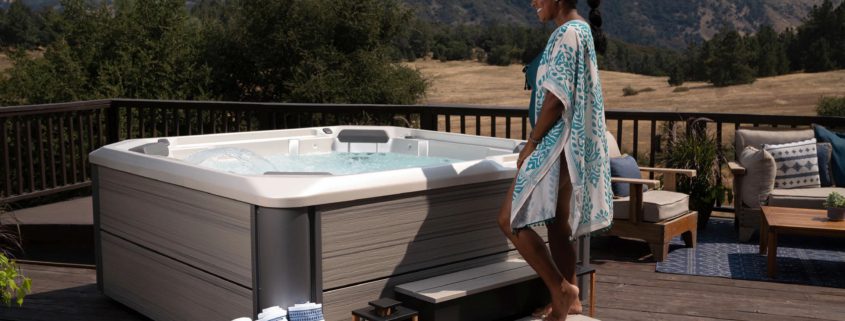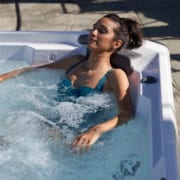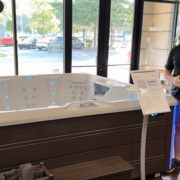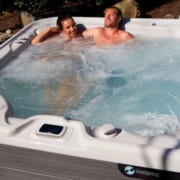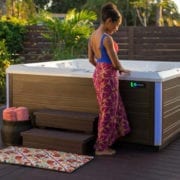Hot Tub Facts and Stats – What You Need to Know Before Buying a Spa
It feels great to soak in a hot tub, and all of the hot tubs you’ve looked at are beautiful. So, how do you decide?
You want to make your choice based on clear facts, hard statistics, and answers to a few simple questions. For example, what’s your budget? Are you looking for more family time, pain relief, better health or all of three? How do your top choices compare to one another?
To help you make this important decision and life-long investment, we put together some hot tub facts and stats including what you need to know before buying a spa.
Looking at Hot Tub Specifications
When thinking about buying a hot tub, you want to consider the models that meet both your budget and your needs.
The first thing to look at is the hot tub’s specifications. Most manufacturers list the specifications of each model right on their website, allowing for easy comparison. But, this only helps if you know how to interpret that information.
Here are some important details to consider.
- Seats. The more seats in your hot tub, the more friends and family can enjoy it with you. Seven seats is usually more than ample for most people, but to determine the number of seats that are right for you, think about who’ll use your hot tub every day. Then, consider how many invited guests might use it. If there are four people in your family, and you entertain guests on weekends, you’ll want a hot tub that will accommodate everyone. Hot tub prices can rise with the seat number, so you want to keep that in mind.
- Dimensions. Consider the dimensions of your hot tub along with the number of seats because the number of seats doesn’t always mean a bigger hot tub. You want to account for seats as well as spaciousness. You also want to look at the height of the spa because the shorter your hot tub, the less you can fully immerse in the water if you are tall.
- Jets. When it comes to jets, more doesn’t always mean better. Jet positioning and design enhance your hydro-massage experience, and they are more important than the number of jets. Just remember that the more jets you have, the more pressure the pumps need to supply. So, you need to consider pump power as well. Jet design also plays an important role in pressure delivery and your ultimate experience. Think of the difference in pressure delivery when you use a garden hose with a nozzle to wash your car or water your garden versus simply putting your thumb over the end of the hose. Ask your dealer to describe the specific details.
- Water Capacity. The larger the spa, the more gallons it holds. This number is crucial to determining how long it takes to drain and refill your hot tub, and how much it might cost. Discuss water capacity with your dealer.
- Pumps. Your pumps determine the pressure behind your jets. Pressure is critical when counting on your hot tub for pain relief and better health. Look at the continuous-duty horsepower for comparisons.
- Wattage. Wattage is determined by multiplying volts by amps. To understand what these numbers mean for your hot tub, picture water running through a pipe. Volts roughly correspond to PSI (pounds per square inch)—the amount of pressure forcing the water through the pipe. Amps roughly correspond to GPM (gallons per minute), or the amount of water delivered through the pipe. The higher the wattage, the greater electricity is required. But high wattage also influences performance—the higher the number, the more efficiently your hot tub heats. If your hot tub only requires 110 volts, you can plug it directly into a standard home outlet; if it requires 220 volts or more, you need to install an appropriate outlet. We can explain what that entails.
- Heater. Your hot tub heater has one job, and that’s to heat your water. A high-voltage spa takes more energy to run than a low-voltage spa, but it won’t need to run as long to heat the water to your ideal temperature. Less powerful heaters work more, and work harder, so always factor in how often you plan to use your spa when comparing models.
Looking at Hot Tub Statistics
In the United States, there are roughly 5.8 million hot tubs. This isn’t a huge surprise because hot tubs can last 20 years or longer. Most hot tubs are found in single family homes, but some are found in condos and apartments.
When considering price, average installation and operation costs as well as benefits and safety, let’s look at these stats.
Hot Tub Price Ranges
-
- Luxury hot tubs: $13,000+
- All the Bells and Whistles hot tubs: $11,000-$12,999
- Premium hot tubs: $9,000-$10,999
- Most affordable hot tubs: $7,000-8,999
- Entry-level hot tubs: Up to $6,999
Average Installation Costs
- Installation costs can range up to $500 (and sometimes more) and depend on hot tub location, size, and complexity of the installation.
- Installing a hot tub on a concrete pad in a suburban backyard with easy access is routine.
- If your installation is more involved, such as if a crane is needed to lift your hot tub to your rooftop deck, the cost rises.
Average Monthly Electricity Cost
- Hot tubs typically cost between $10-20 per month to run.
- But there are a few variables to consider.
- Hot tubs are more expensive to heat in the winter than the summer, and larger hot tubs cost more to heat than smaller ones.
- The more you use your hot tub, the more heat you lose to ambient air, requiring your heater to use more energy.
- Owning a modern, energy-efficient hot tub with improved insulation and powerful heaters can contain these costs.
Average Water Care Cost
- The basic level of hot tub water care (using bottled chemicals) costs around $20 per month.
- Upgrading to a water care system, raises raise the cost slightly but reduces the need for chlorine and saves you time on water maintenance.
- Top-tier saltwater systems, like the ACE System creates water cleaners from salt, also reducing the need for chemical additives. These systems cost more up front, but they can significantly reduce monthly costs and water maintenance time.
Hot Tub Benefits
- Better Sleep. According to the National Sleep Foundation, more than 130 Americans suffer from some type of sleep disorder at least one night per week. If you have trouble sleeping, your hot tub can help. A 15-minute soak about 90 minutes before you go to bed causes a drop in body temperature as you cool down, helping to ease you into a deep, relaxing slumber.
- Improved Mobility. As you relax in your hot tub, your body presses against the warm water. As it does, the water presses back, lifting you. The buoyancy of spas can provide temporary alleviation of arthritis symptoms, including swelling, pain, stiffness, and aid in joint motion and function. While soaking in a spa is recommended for many arthritis sufferers, it is not for everyone. Always consult your physician for health advice.
- Deeper Social Connections. Your hot tub provides the perfect spot to gather with family and friends and nurture those relationships. Spending quality time together, conversing or just relaxing far away from technology and the pressures of work is fun for all.
Hot Tub Safety Facts
- Recommended Temperature. The water in your hot tub should not exceed 104 degrees Fahrenheit, and the recommended temperature is 100 degrees. Special care should be taken with young children.
- Safe Age for Children. The U.S. Centers for Disease Control and Prevention recommends that children under the age of five not be permitted inside a hot tub.
With these facts and stats in hand, you’re now prepared to browse our models online or visit us. We’re here and ready to answer your questions to help you find the perfect hot tub for your family, your needs and your budget.
To learn more, download our hot tub buying guide or request a quote today!

